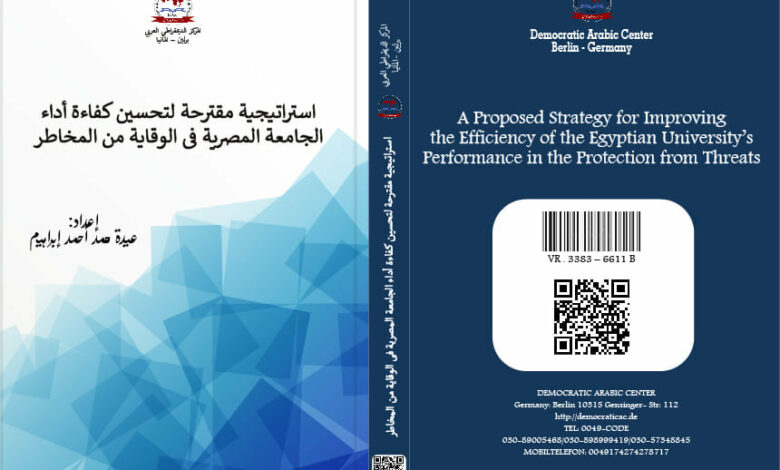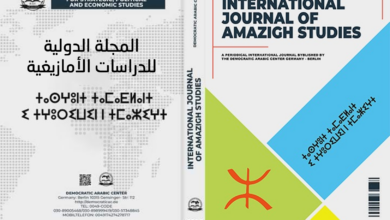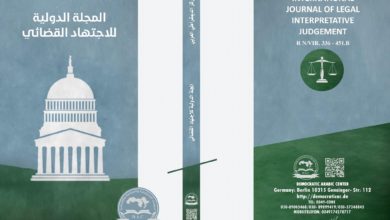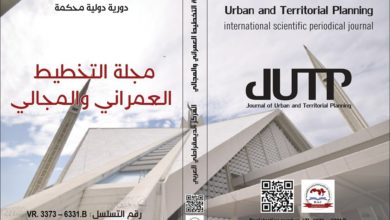استراتيجية مقترحة لتحسين كفاءة أداء الجامعة المصرية فى الوقاية من المخاطر
A proposed strategy to improve the efficiency of the performance of the Egyptian University in the prevention of risks

تأليف : د . عيدة محمد أحمد إبراهيم
نسخة “pdf”-
استراتيجية مقترحة لتحسين كفاءة أداء الجامعة المصرية فى الوقاية من المخاطر
الطبعة الأولى “2022″ –من كتاب: – استراتيجية مقترحة لتحسين كفاءة أداء الجامعة المصرية فى الوقاية من المخاطر
جميع حقوق الطبع محفوظة #المركز_الديمقراطي_العربي ولا يسمح بإعادة إصدار هذا الكتاب أو اي جزء منه أو تخزينه في نطاق إستعادة المعلومات أو نقله بأي شكل من الأشكال، دون إذن مسبق خطي من الناشر .
تقديم:
مما لا شك فيه أن تطوير أي مؤسسة يتوقف بقدر كبير على القدرة على استشراف المخاطر والتحسب لها ووضع مجموعة من الإجراءات الاحترازية المناسبة لها، والجامعات مثلها مثل أي مؤسسة بل لها أهميتها الخاصة المترتبة على أدوراها وطبيعة عملها، ولعل هذا ما يوضح ويفسر الاهتمام المتزايد بمجال إدارة المخاطر باستخدام مناهج ومفاهيم واستراتيجيات التخطيط الاستراتيجي في تنامى الدراسات التي تهتم بدراسة الأزمات والمخاطر التي تواجه الجامعات، لاستشرافها واستباقها ووضع اقتراحات لحلها والتغلب عليها، والحرص الشديد على عدم الوصول لمرحلة الأزمة، بل وقد أصبح هذا النهج اتجاهاً عالمياً تتوجه إليه كبرى الجامعات في مختلف الدول، بهدف تأمين الجامعات ولحفاظ عليها في مواجهة التهديدات ،ومساعدتها على تحقيق أهدافها .
وقد استهدفت الدراسة الحالية وضع استراتيجية مقترحة لتحسين كفاءة أداء الجامعة المصرية فى الوقاية من المخاطر وذلك عن طريق ما يلي:
- تحليل الأسس والمنطلقات الفكرية لإدارة الوقاية من المخاطر في ضوء الفكر المعاصر.
- تحليل العوامل الحاكمة لتحسين كفاءة أداء الجامعة فى الوقاية من المخاطر في ضوء نموذج إدارة المخاطر المؤسسية (ERM) Enterprise Risk Management
- تحديد كيف تساهم الدراسات المستقبلية والتخطيط الاستراتيجي في دعم إدارة الوقاية من المخاطر ودعم نموذج إدارة المخاطر المؤسسية (ERM) Enterprise Risk Management
- تحليل بعض الخبرات والممارسات العالمية في تطوير كفاءة أداء الجامعة فى الوقاية من المخاطر
- رصد وتحليل واقع ممارسات الوقاية من المخاطر بجامعة عين شمس.
- وضع ملامح استراتيجية مقترحة لتحسين كفاءة أداء الجامعة المصرية فى الوقاية من المخاطر.
ولتحقيق أهداف الدراسة اعتمدت الدراسة في منهجيتها المنهج الوصفي الذي يقوم بدراسة واقع الظاهرة في سياقها كما استعانت الدراسة بأدوات البحث (الاستبانة – المقابلة) وذلك لرصد واقع ممارسات إدارة الوقاية من المخاطر في جامعة عين شمس. بالإضافة إلى أسلوب تحليل النظم.
وقد توصلت الدراسة إلى مجموعة من النتائج النظرية والميدانية كالتالي:
أولاً: نتائج الدراسة النظرية
- امتداد الجذور الفكرية لمفهوم الوقاية من المخاطر إلى الحضارات القديمة وتغلغل فكر الوقاية من المخاطر في الثقافة العربية والنتاج الأدبي والفكري للمجتمع العربي.
- أهمية إدارة الوقاية من المخاطر في أي مؤسسة ومنها والجامعات.
- ضرورة وجود إدارة للوقاية من المخاطر بالجامعات بشكل منظم وممنهج ومعلن بالاستراتيجية العامة للجامعة.
- العلاقة الوثيقة بين الوقاية من المخاطر وكفاءة وفاعلية الجامعة.
- هناك بعض التهديدات والمخاطر التي تحيط بالجامعة.
- هناك خلط والتباس بين مفهوم المخاطر ومفاهيم أخري كالمشاكل والكوارث والأزمات.
- تعاني الجامعات المصرية من الكثير من المخاطر والتهديدات مما انعكس على تأخر مكانتها بين مثيلاتها إقليمياً وعالمياً.
- استشراف المخاطر يؤمن الجامعة ويدعم تحقيق أهدافها ويوثق علاقتها بالمجتمع.
- ندرة الدراسات التي تناولت إدارة الوقاية من المخاطر في الجامعات المصرية.
- اهتمام الجامعات العالمية بنشر فكر واستشراف المخاطر، ووضع وتنفيذ استراتيجيات للوقاية من المخاطر، وانعكاس هذا على رفع مكانة الجامعة.
- يتوقف نجاح إدارة الوقاية من المخاطر الجامعية على تفاعل واشتراك جميع أطراف المنظومة الجامعية (أكاديميين- طلاب- إداريين)
- تتطلب إدارة الوقاية من المخاطر الجامعية تقديم ندوات ودورات وتجهيزات داعمة.
- هناك علاقة وثيقة بين إدارة الوقاية من المخاطر وأنظمة الرقابة الداخلية والحوكمة والتنمية المستدامة وتحقيق متطلبات الجودة للجامعة.
- أن إدارة الوقاية الجامعية لا تؤتي ثمارها إلا إذا تمت في وسط مناسب لتنميتها وازدهارها، وتخطيط رشيد، وعمليات منظمة تهتم وتدعم التغذية المرتدة لها.
- يمكن إجمال الأبعاد المؤثرة على دمج إدارة الوقاية من المخاطر في المنظومة الجامعية في البعد الفلسفي، والبعد السياسي والثقافة المؤسسية والدعم التمويلي ونظم المعلومات والبيانات، وتكنولوجيا الاتصالات، إلى جانب الأبعاد الإدارية، والتنظيمية، وأدوار الأفراد ومهاراتهم، والبعد الإداري والتنظيمي ، وأنظمة الرقابة الداخلية والتقويم.
- نجاح إدارة الوقاية من المخاطر بالجامعة في عملها يدعم الجامعة في تحقيق أهدفها والقيام بوظائفها.
- للوقاية من المخاطر عدة أساليب ومناهج تطبيقية يمكن الاختيار من بينها بما يتواءم مع طبيعة وظروف كل جامعة.
ثانياً: نتائج القسم الميداني
- نتائج المحور الأول: التخطيط
أظهرت النتائج أن هذا المحور تحقق بشكل عام بمسوى مرتفع حيث تراوحت الأوزان النسبية للمحور في عينة أعضاء هيئة التدريس ما بين (2.28) و(2.74)، وفي عينة الإداريين ما بين(2.45) و(2.67)، وفي عينة الطلاب ما بين (2.38) و(2.54)، وهو مستوى مرتفع، مما يؤكد أهمية التخطيط في إدارة الوقاية من المخاطر.
- نتائج المحور الثانى: مجال المعلومات
أظهرت النتائج أن هذا المحور تحقق بشكل عام بمسوى مرتفع حيث تراوحت الأوزان النسبية للمحور في عينة أعضاء هيئة التدريس ما بين(2.22) و(2.72)، وفي عينة الإداريين (2.34) و (2.73)، وفي عينة الطلاب (2.41) و(2.45)، وهو مستوى مرتفع، وقد اتضح من نتائج هذا المحور أهمية دور المعلومات في إدارة الوقاية من المخاطر.
- نتائج المحور الثالث :دور نظم الاتصالات في الوقاية من المخاطر
أظهرت النتائج أن هذا المحور تحقق بشكل عام بمسوى مرتفع حيث تراوحت الأوزان النسبية للمحور في عينة أعضاء هيئة التدريس ما بين (2.16) و(2.67)، وفي عينة الإداريين (2.35) و(2.64)، وفي عينة الطلاب (2.42) و(2.48) وهو مستوى مرتفع وقد اتضح
أهمية دور نظم الاتصالات في الوقاية من المخاطر.
- نتائج المحور الرابع : مجال المهارات القيادية
أظهرت النتائج أن هذا المحور تحقق بشكل عام بمسوى مرتفع، حيث تراوحت الأوزان النسبية للمحور ما بين (2.35) و(2.80)، حيث توصلت الدراسة إلى أهمية القيادة في عمليات الوقاية من المخاطر، وضرورة تحقق سمات القيادة في رئيس فريق الوقاية من المخاطر.
- نتائج المحور الخامس: فريق العمل
أظهرت النتائج أن هذا المحور تحقق بشكل عام بمسوى مرتفع، حيث تراوحت الأوزان النسبية للمحور ما بين (2.46) و(2.79)، وكانت نتائج هذا المحور تشير إلى أهمية إعداد فريق العمل الخاص بالوقاية من المخاطر، وضرورة أن يتصف هذا الفريق بعدة صفات تمكنه من العمل.
- كما رصدت الدراسة الميدانية عدة حقائق عن واقع ممارسات المخاطر بجامعة عين شمس كالتالي :
- يوجد ممارسات للوقاية من المخاطر بجامعة عين شمس.
- كليات جامعة عين شمس لا تطبق إدارة الوقاية من المخاطر بشكل مؤسسي مستدام.
- لا يوجد لها سياسات وإجراءات صريحة ومعلنة لدعم مأسسة إدارة الوقاية من المخاطر مما أدى إلى غموض مفهوم الوقاية من المخاطر لدى البعض.
- اقتصار أنشطة الوقاية من المخاطر بالجامعة على بعض الندوات والدورات التدريبية.
- لا تقدم جامعة عين شمس الدعم والتشجيع المناسبين للمشاركين في دوراتها وندواتها حول الوقاية من المخاطر.
- تتوافر لدى جامعة عين شمس نظم اتصالات متنوعة تصلح لدعم إدارة الوقاية من المخاطر.
- تمتلك جامعة عين شمس كوادر أكاديمية تكفي لدعم أدارة الوقاية من المخاطر.
- أبدي كثير من الموارد البشرية بالجامعة(أكاديميين- طلاب- إداريين) استعداهم للمشاركة في أنشطة إدارة الوقاية من المخاطر.
- نجاح الجامعات المصرية ومن بينها جامعة عين شمس في إدارة أزمة جائحة كورونا (كوفيد19) مما ينبئ بمقدرة هذه الجامعات على دعم وتنفيذ دمج إدارة الوقاية من المخاطر والقدرة على القيام بعملها بشكل مؤسسي ناجح.
- استطاعت جامعة عين شمس أن تجني أثار إيجابية نتيجة لقدرتها على التعامل مع أزمة جائحة كورونا(كوفيد 19)، وحسن استغلال أزمة جائحة وباء كورونا، وتمثلت هذه الأثار الإيجابية في التحول لنمط التعليم البديل وتحقيق المزيد من القدرة على أنماط التعليم الإلكتروني واستخدام الوسائط والوسائل التكنولوجية بنجاح.
Abstract
There is no doubt that the development of any institution depends to a large extent on the ability to anticipate risks and anticipate them and set a group of appropriate precautionary measures for them, and universities are like any institution, but rather have their own importance resulting from their roles and the nature of their work, and perhaps this is what clarifies and explains the growing interest in the field of Risk Management using approaches, concepts and strategies of strategic planning in the growth of studies that are concerned with studying crises and risks facing universities, to anticipate and develop proposals to solve and overcome them, and take great care not to reach the stage of the crisis. With the aim of securing universities and preserving them in the face of threats, and helping them achieve their goals.
The current study aimed to develop a proposed strategy to improve the efficiency of the Egyptian university’s performance in the protection from threats, through the following
- Analyzing the intellectual foundations of threats protection management in the light of contemporary thought.
- Analyzing the governing factors of improving the efficiency of the university’s performance in threats protection in the light of the Enterprise Risk Management (ERM) model
- Determine how future studies and strategic planning contribute to supporting threats protection management and the Enterprise Risk Management model.
- Analysis of some global experiences and practices in developing the efficiency of the university’s performance in the protection from threats.
- Monitoring and analyzing the reality of protection from threats practices at Ain Shams University.
- Develop a proposed strategy for improving the efficiency of the Egyptian university’s performance in the protection from threats.
In order to achieve the objectives of the study, descriptive method of research and systems analysis method were adopted . In addition, the study adopted two data collecting tools (questionnaire – interview) to gather data about the reality of protection from threats practices at Ain Shams University.
The study reached a set of theoretical and field results as follows:
First: Results of the theoretical framework of the study
- The intellectual roots of the concept of threats protection traces back to ancient civilizations and the Arab culture.
- The importance of threats protection management in any institution, including universities.
- The necessity of having a threats protection unit in universities in an organized and systematic manner, and announced in the general strategy of the university.
- The close relationship between threats protection and university efficiency and effectiveness.
- There are some threats and dangers surrounding the university.
- There is confusion between the concept of risk and other concepts such as problems, disasters and crises.
- Egyptian universities suffer from many risks and threats, which is reflected in their position among their regional and global counterparts.
- Foresight of risks secures the university and supports the achievement of its goals and strengthens its relationship with society.
- The scarcity of studies that dealt with threats protection management in Egyptian universities.
- The interest of international universities in spreading thought and exploration of risks, and developing and implementing strategies to prevent risks, and this is reflected in raising the status of the university.
- The success of the university Threats Protection Unit depends on the interaction and participation of all parts of the university system (academics – students – administrators).
- The university Threats Protection Unit requires the provision of seminars, courses and supportive equipment.
- There is a close relationship between the Threats Protection Unit, internal control systems, governance, sustainable development and achieving the university’s quality requirements.
- The university Threats Protection Unit does not bear its fruits unless it is carried out in a suitable environment for its development and prosperity, rational planning, and organized operations that take care of and support its feedback.
- The dimensions affecting the integration of threats protection management into the university system can be summarized in the philosophical, political dimensions, institutional culture, financing support, information and data systems, communication technology, as well as the administrative and organizational dimensions, the roles and skills of individuals, the administrative and organizational dimension, and internal control systems.
- The success of the university’s Threats Protection Unit in its work supports the university in achieving its goals and carrying out its functions.
- Threats protectionhas several methods and applied approaches that can be chosen in line with the nature and conditions of each university.
Second: Results of the field section of the study:
The results of the first axis: planning
The results showed that this axis was achieved in general at a high level, as the relative weights of the axis in the faculty sample ranged between (2.28) and (2.74), and in the administrators sample between (2.45) and (2.67), and in the student sample between (2.38). ) and (2.54), which is a high level, which confirms the importance of planning in threats protection management.
Results of the second axis: the field of information
The results showed that this axis was achieved in general at a high level, as the relative weights of the axis in the faculty sample ranged between (2.22) and (2.72), and in the administrators sample (2.34) and (2.73), and in the student sample (2.41) and (2.45). ), Which is a high level, and it became clear from the results of this axis the importance of the role of information in threats protection management
Results of the third axis: the role of communication systems in the protection from threats
The results showed that this axis was achieved in general at a high level, as the relative weights of the axis in the faculty sample ranged between (2.16) and (2.67), and in the administrators sample (2.35) and (2.64), and in the student sample (2.42) and (2.48), which is a high level, and it turns out the importance of the role of communication systems in the protection from threats.
Results of the fourth axis: the field of leadership skills
The results showed that this axis was achieved in general at a high level, as the relative weights of the axis ranged between (2.35) and (2.80), as the study found the importance of leadership in threats protection processes, and the need to achieve leadership characteristics in the head of the threats protectionteam.
The results of the fifth axis: the work team
The results showed that this axis was achieved in general at a high level, as the relative weights of the axis ranged between (2.46) and (2.79). the work.
The field study also monitored several facts about the reality of threats protection practices at Ain Shams University, as follows
- There are protection from threats practices at Ain Shams University.
- Ain Shams University colleges do not apply threats protection management in an institutionalized manner.
- Ain Shams University has no explicit and announced policies and procedures to support the institutionalization of threats protection management, which led to the ambiguity of the concept of threats protection for some employees.
- The university’s threats protection activities are limited to some seminars and training courses.
- Ain Shams University does not provide appropriate support and encouragement to the participants in its courses and seminars on threats protection.
- Ain Shams University has various communication systems available to support the Threats Protection Unit.
- Ain Shams University has enough academic cadres to support the Threats Protection Unit.
- Many human resources at the university (academics – students – administrators) have shown their willingness to participate in the activities of the Threats Protection Unit.
- The success of Egyptian universities, including Ain Shams University, in managing the Corona pandemic crisis (Covid 19), which predicts the ability of these universities to support and implement the integration of threats protection management and the ability to carry out their work in a successful institutional way.
- Ain Shams University was able to reap positive effects as a result of its ability to deal with the crisis of the Corona pandemic (Covid 19), and the good use of the pandemic crisis of the Corona epidemic, and these positive effects were represented in the shift to alternative education and achieving more capacity for e-learning patterns and the successful use of media and technology.
- الناشر: المركز الديمقراطي العربي للدراسات الإستراتيجية والسياسية والاقتصادية





